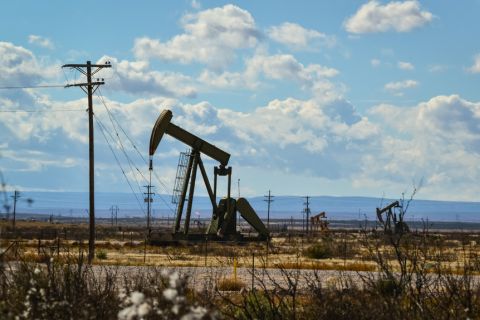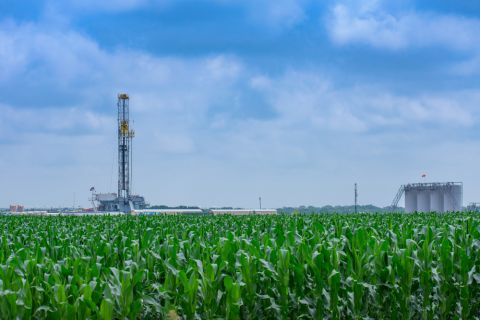The Independence Hub Facility is installed in Mississippi Canyon Block 920 in the Gulf of Mexico in 8,000 ft water depth. The Independence Hub facility consists of a semisubmersible hull with integrated topsides and a 12-line taut polyester mooring system, which supports the steel catenary risers (SCRs).
 |
|
| Figure 1. Mooring Line Deployment Winch (MLDW) is shown onboard Balder. (Images courtesy of Heerema) |
The mooring system consists of a 12-leg, taut polyester mooring system. It includes suction piles, 100-ft (30.5 m) pile chain, subsea connector, 800-ft (244 m) bottom chain, polyester mooring rope in three segments totalling 10,800 ft (3,294 m) connected by H-links, two polyester test inserts and 1,000 ft (305 m) of platform chain.
The SCRs connect a network of flow lines to the hub facility. The Independence Trail export SCR originates from the Hub facility with a 20-in. SCR. This 20-in. SCR holds the record of world’s deepest and heaviest riser installation.
Hub installation
The installation was split into three phases: the installation of suction piles, the installation of the hull and moorings, and the installation of SCRs. Heerema Marine Contractors’ (HMC) Deepwater Construction Vessel (DCV) Balder and specific, purpose-built installation equipment were used in all phases.
Suction piles
The first phase, installation of the suction piles, was executed from April 2006 through May 2006. This phase involved transportation and installation of 12 mooring assemblies, each consisting of a suction pile, anchor chain, connecting shackles and a male subsea connector. After transport of the components, all components were transferred from the material barges to the Balder deck. The components were assembled and then lifted, upended, over-boarded and installed.
The piles were lifted by the Balder cranes (dual crane), with a suction pile lift frame at the top and a lower rigging arrangement at the bottom. The piles were upended above the deck. After upending, the lower rigging arrangement was released, and the piles were over-boarded and lowered to their final location. The piles were lowered to approximately 10 ft (3 m) above the seabed, and preparations were made to stab and penetrate the pile according to the required installation tolerances. The orientation and location were verified by ROV and transponders on the pile. After initial stabbing, the pile was lowered 10 ft to stabilize the pile and to confirm if the pile position, orientation and inclination were within installation tolerances. The pile was then allowed to penetrate to self-weight penetration.
After self-weight penetration was reached and the valves on top of the pile were closed, a suction system was engaged into the pile top to bring the pile to the final penetration. All piles were installed within the required tolerances for positioning, orientation and inclination.
Hull and moorings
The second phase, installation of the semisubmersible hull and moorings, was executed in February 2007. The platform was delivered to HMC at location. HMC took over control of the semi when it was in the vicinity of the Balder, prior to beginning mooring line hook-up. The tugs from the offshore tow spread were assigned to HMC for the infield station keeping and positioning of the platform during the hookup operations.
Transport of the mooring components was performed by HMC on 400-ft (122-m) barges. Upon arrival in the field, the material barge was moored to the DCV for the transfer of the mooring components for the first four lines.
The first component to be deployed overboard was the bottom chain with the female subsea
 |
|
| Figure 2. Balder works on Independence Hub. |
The Mooring Line Deployment Winch (MLDW) was used to deploy the polyester mooring line segments. The rope segment was spooled onto the MLDW drum from the transport spools. After spooling, the connection was made to the bottom chain, which then was released from the hang-off platform. Two segments of polyester were paid out while deploying the bottom chain and connector to the suction pile. The female connector was engaged to the male connector on the pile. The third polyester segment was deployed after connection of a support vessel to the H-link at the polyester-to-polyester connection above the second segment. The support vessel was used to make sure the polyester did not make contact with the sea bottom.
When the third segment was deployed and hung off at the hang-off platform, the platform chain was laid on the deck (similar to the bottom chain) and twists were removed. The chain was connected to the test inserts and the third segment, ready for over-boarding. The Balder moved to the semisubmersible hull for the mooring line hookup. When in vicinity of the hull, the Balder transferred the messenger chain (pre-installed at the hull) to the Balder, and the connection was made between the messenger chain and platform chain. While monitoring vessel positions within the seabed clearance envelope, the platform chain was lowered and messenger chain hauled in to transfer the mooring line load to the semisubmersible. This deployment and hookup sequence was repeated until all 12 lines were installed.
SCR installation
The third phase, SCR installation, was partly executed in March 2007. HMC’s scope was the installation of five 8-in. SCRs, two 10-in. SCRs and the 20-in. export SCR to the Hub Facility. Three 8-in. SCRs and the export SCR have been installed at this writing. Two
8-in. SCRs and two 10-in. SCRs will be installed later this year.
All SCRs were constructed and temporarily stored pre-laid on the seabed. Each SCR consists of steel pipe with an integrated flex-joint and an SCR head on the pipe end. Pre-installed on the SCRs are strakes and fairings to avoid vortex-induced vibrations, a flex-joint protective cover, flex tool, pipe flooding valve, hangoff collar and a pickup rigging arrangement including buoy for installation purposes.
The SCRs were picked up by the Balder Abandonment and Recovery Winch (A&R Winch). During the pickup, the Balder moved in towards the hull. When in close vicinity of the hull, the Balder picked up a previously installed cross-haul wire from the hull and made the connection to the SCR. After connecting this cross-haul wire, the A&R winch was paid out so the load of the SCR was transferred from the winch to the hull. The Balder moved to the opposite site of the hull to pick up the SCR from the cross-haul wire with the A&R Winch. After releasing the cross-haul wire, the Balder moved out to standoff distance, where a connection of the SCR with the Balder portside crane could be made. The portside crane was slewed over the J-lay tower, and the crane block was lowered to the SCR head. The rigging was connected subsea to the SCR, and the crane was slewed to the Balder stern. At this moment the A&R wire was paid out to transfer all load from the winch to the crane. The A&R winch was disconnected when slack.
The SCR was hoisted to the Balder deck level, where flex tool and protection covers were removed. When the Balder was at approximately 131 ft (40 m) from the hull, the connection with the previously installed pull-in wire was made. The SCR was pulled in by a linear winch on the Hull and lowered into its porch by the Balder crane.
Recommended Reading
Chevron CEO: Permian, D-J Basin Production Fuels US Output Growth
2024-04-29 - Chevron continues to prioritize Permian Basin investment for new production and is seeing D-J Basin growth after closing its $6.3 billion acquisition of PDC Energy last year, CEO Mike Wirth said.
Novo II Reloads, Aims for Delaware Deals After $1.5B Exit Last Year
2024-04-24 - After Novo I sold its Delaware Basin position for $1.5 billion last year, Novo Oil & Gas II is reloading with EnCap backing and aiming for more Delaware deals.
Enverus: 1Q Upstream Deals Hit $51B, but Consolidation is Slowing
2024-04-23 - Oil and gas dealmaking continued at a high clip in the first quarter, especially in the Permian Basin. But a thinning list of potential takeout targets, and an invigorated Federal Trade Commission, are chilling the red-hot M&A market.
EIA: Permian, Bakken Associated Gas Growth Pressures NatGas Producers
2024-04-18 - Near-record associated gas volumes from U.S. oil basins continue to put pressure on dry gas producers, which are curtailing output and cutting rigs.




